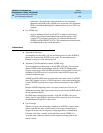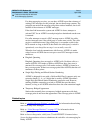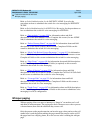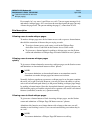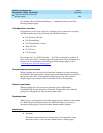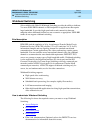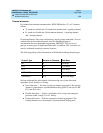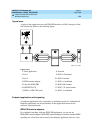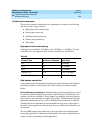
DEFINITY ECS Release 8.2
Administrator’s Guide
555-233-506
Issue 1
April 2000
Features and technical reference
1587Wideband Switching
20
Wideband Switching
(Not available with Offer B) Wideband Switching provides the ability to dedicate
2 or more ISDN-PRI B-channels or DS0 endpoints for applications that require
large bandwidth. It provides high-speed end-to-end connectivity between
endpoints where dedicated facilities are not economic or appropriate. ISDN-BRI
trunks do not support wideband switching.
Brief description
ISDN-PRI (and the emulation of it by Asynchronous Transfer Mode-Circuit
Emulation Service (ATM-CES)) divides a T1 or E1 trunk into 24 (31 for E1)
information channels and one signaling channel for standard narrowband
communication. Certain applications, like video conferencing, require greater
bandwidth. You can combine several narrowband channels into one wideband
channel to accommodate the extra bandwidth requirement. DEFINITY ECS
serves as a gateway to many types of high-bandwidth traffic. Wideband switching
is also supported by the Expansion Interface (EI) circuit pack and the DS1
Converter circuit pack (for Center Stage Switching or directly connected port
networks) and the ATM-EI circuit pack (for Asynchronous Transfer Mode
connected port networks). ATM-CES supports wideband switching only for
access, tie, and tandem trunks, not for line-side connections.
Wideband Switching supports:
■ High-speed video conferencing
■ WAN disaster recovery
■ Scheduled batch processing (for example, nightly file transfers)
■ LAN interconnections and imaging
■ Other high bandwidth applications involving high-speed data transmission,
video transmission, etc.
How to administer Wideband Switching
The following list shows the required screens you must to set up Wideband
Switching:
■ Access Endpoint
■ PRI Endpoint
■ ISDN trunk group
■ Route Pattern
■ Fiber Link Administration (Optional: refer to the DEFINTY services
documentation for information about this screen.)



